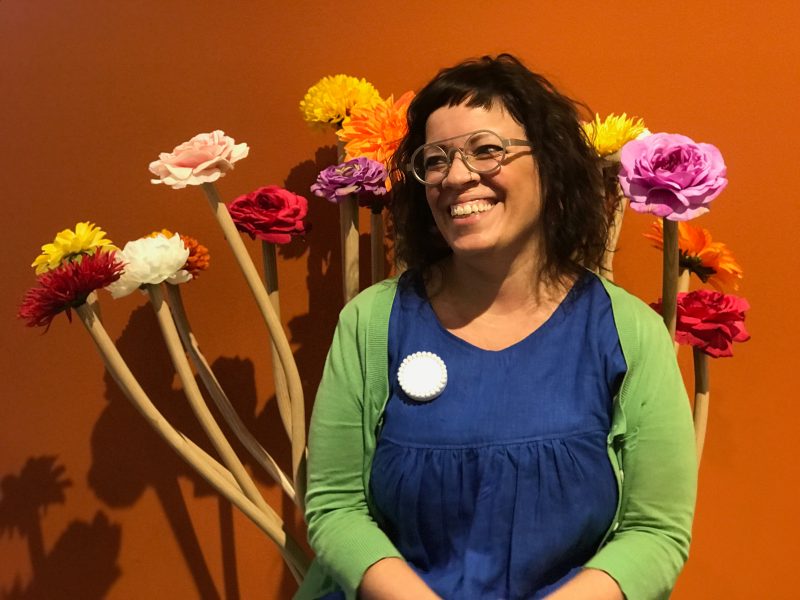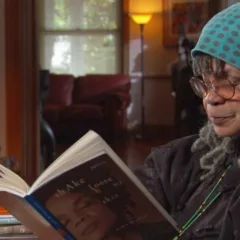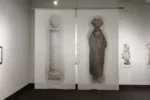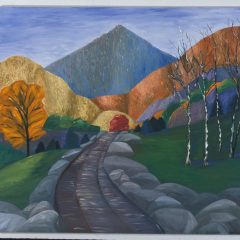
For the past year and a half, The Center for Art in Wood has been led by a woman visionary who has brought exhibitions to Philadelphia that are true game changers. Jennifer-Navva Milliken, or Navva as she is called by many, the current Artistic Director of the Center, brings with her years of impactful curatorial work and museum leadership from institutions like the Museum of Arts and Design in NYC and the Department of Design and Architecture in the Israel Museum in Jerusalem. This deep knowledge of the inner workings of museums drives the prolific nature of her work with the Center as well.
Wit Lopez: Would you consider The Center for Art in Wood a museum?
Jennifer-Navva Milliken: That is such a provocative question. The Center has been developed over the last 30 years as a place for encountering art in wood. I think as different forms of art-making have been accepted and different kinds of conversations have come out, the comfort of in calling this “The Center for Art, Craft, and Design in Wood” has created the opportunity for richer conversations here. It’s a positive development.
We have a museum-quality collection of 1200 objects that chart the development of wood-turning, in particular, as an expressive and artistic medium. In recent years, the Center changed its name from The Woodturning Center to The Center for Art in Wood and expanded its mission, which allows us to look at studio furniture, the design and production of furniture and objects, and the craft around those objects. It allows me to continue doing what I’ve done in my career leading up to here.
WL: I know that the Center has a gallery, it also has a gift shop, a permanent collection upstairs, and a library. What are the resources available at the Center? What can folks come see or do?
JNM: Thank you for mentioning the library because that is an overlooked resource here. We have tens of thousands of volumes, published books available for our members or for people who set up an appointment to come look at. We also have upwards of 15,000 artist files that are maintained and regularly updated. The artist files contain documentation that chart the artist’s career, small publications or small monographs that a gallery or museum might publish on the occasion of a solo exhibition, it’s resumes, it’s correspondence. The are living files that represent an archive of artists and their careers, whether they interact with the Center or other organizations.
We also have a residency program that occurs annually. It’s called the Windgate International Turning Exchange Residency Program. It happens every year from June to August and we welcome eight residents to be here with us for that 8-week period. Who are the residents? They are five professional artists, one student, and one visual documentarian. We also have a researcher or scholar who joins the residents at the mid-point and spends a week with them, embedded. Hopefully, that research can inform the work that they are doing on a larger scale, but also they write a little piece for us as an observation of what they learned while they were here. It’s a really interesting and unique residency program that offers a lot to the artists who participate, both in terms of resources and hopefully, in terms of visibility. We have an exhibition that is produced at the conclusion of the residency and continues as part of our regular exhibition schedule on an annual basis. It’s one of the most anticipated exhibitions on our program. It brings people from all over the region to check out the works that are incomprehensibly done in two months. It’s amazing to see how exceptionally resolved and beautifully made these objects are that are on view. It’s a fantastic example of the skill of the artists who are here for the residency program.
The galleries here are our most public-facing program. Because we have our collection on view throughout the year, I look at the galleries as an opportunity to show how artists are pushing the field or challenging conceptions and conventions surrounding our understandings of what art in wood can mean, while also maintaining that balance between traditional and heritage practices in the field, or in things like Damien’s work where wood doesn’t play the starring role in the work, but it does offer a really, really important subtext.
We have a store which offers delightful things to our visitors. We also have educational programming, which is a newer facet of the organization, but something that we’re ambitious about building.

WL: As far as the permanent collection, how are things selected for that? I was told that some of the Windgate ITE residents leave things here after the end of their residencies, are those things connected?
JNM: I believe that between 10-15% of the collection resulted from residents who were a part of the ITE program. With regard to that, we ask the residents often if they’re willing to leave one of those objects behind and out collection committee decides which one that is going to be and if that is something the artist wants to do. I think in the past that collection agreement was a little stronger and in later years, as the collection has grown, the committee has become a little more conservative in its activities. Accession into the collection is done as it is with any museum, the artistic director or curator will make a recommendation to the committee and then the committee votes on whether or not to approve that recommendation, and the board, ultimately, takes a vote on whether or not it should be accessioned and brought into the collection. We have been proud to have all of the work on view at all times, whether here at the Center or on long-term loans to other institutions, such as Penn Medicine, which has a very large ceiling installation of work by Daniel Ostrov. We have works on view at Bucks County Community College, most notably, some larger furniture works. They have a strong, rigorous woodworking and furniture program, so there’s a nice synergy there. That’s a way that we have been able to ensure that the works can be enjoyed by the public when we don’t have the option of displaying them here. As we continue to increase and grow the collection, that’s been harder and harder to maintain a commitment to, so we’re figuring out ways to creatively shuffle the way the works are on display. We sometimes allocate a space in the gallery to the display of works from the collection, which changes along with our changing exhibitions.
WL: Can you tell me more about the exhibit “A Seat at the Table?”
JSM: “Making a Seat at the Table: Women Transform Woodworking.” Here’s the origin story of this exhibition: I met a furniture maker and woodworker named Laura Mays last year when I juried her work into a member’s show for the Furniture Society Conference. I’m on the board of the Furniture Society and this is one of the things I was tasked with doing. Laura Mays is also the director of the Krenov School, which is a woodworking school which runs inside the College of the Redwoods in California. She mentioned to me, when I met her, that she and curator Deirdre Visser are working on a book project. That book involves collecting some oral histories and testimonies of women who have been working in the field of woodworking or furniture-making and developed entire careers around this field or are emerging makers, and everyone in between. This book is actually going to be released in 2020. When she mentioned this book project to me, I got really excited and told her, “There has to be a show component, there has to be an exhibition component, and it has to be at the Center!” Here we are… It’s so exciting to me. The show really reflects what is going to be in the book. Woodworking and furniture-making has a history, within the confines of North America, is a male-dominated field. Often makers, who are not male, are confronted with strange attitudes when showing their work. When they are interceding between their work and the public, there are a lot of things that get said to them, such as, “Is your husband or your boyfriend here? Can I talk to him about this work? Did your dad make that?” In thinking about this exhibition, I keep thinking about LInda Nochlin’s 1971 essay, “Why Have There Been No Great Women Artists?” and then the show that came a few years after that was a kind of controversial show, but it was also viewed as a corrective to the way art history gets discussed and handed down. It was a start in the 70’s and we’re still working on it. We’re still at a point in time where we still need to have these kinds of shows to create the possibility for more inclusive futures. We still have a lot of work to do in creating awareness and understanding, and until we get there, we have to do these kinds of projects.
“Making a Seat at the Table: Women Transform Woodworking,” until January 25th. The Center for Art in Wood, 141 N. 3rd Street.









